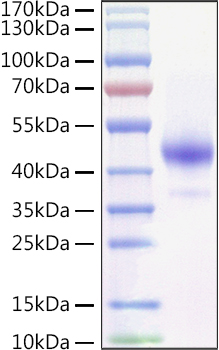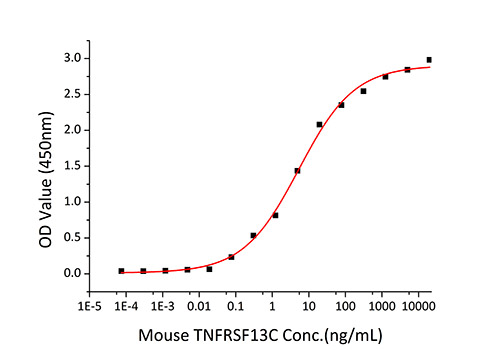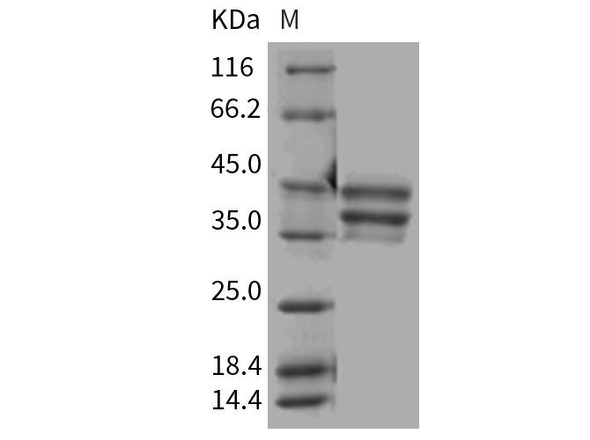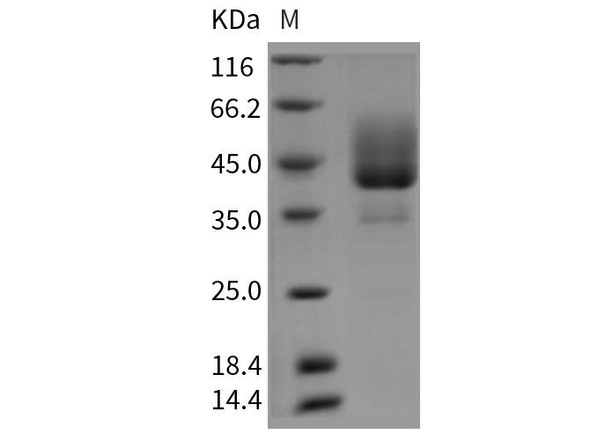Description
Recombinant Mouse TNFRSF13C/BAFFR/CD268 Protein
The Recombinant Mouse TNFRSF13C/BAFFR/CD268 Protein is a high-quality recombinant protein designed for murine biological research applications. This protein serves as an essential reagent in mouse model studies, comparative immunology research, and preclinical therapeutic evaluations, enabling scientists to investigate TNFRSF13C/BAFFR/CD268 biology and its relevance to human disease mechanisms through translational research approaches.
This product (SKU: RPCB1531) is produced using HEK293 cells and features a C-hFc&Avi tag for convenient detection and purification. The protein exhibits a calculated molecular weight of 34.47 kDa with an observed molecular weight of 40-45 kDa under denaturing conditions, achieving ≥ 95 % as determined by SDS-PAGE.. Functional bioactivity has been validated through rigorous quality control assays, confirming its suitability for demanding research applications.
Key Features
| High Purity by Affinity Chromatography | |
| Mammalian & Bacterial Expression Systems | |
| High lot-to-lot consistency via strict QC |
| Product Name: | Recombinant Mouse TNFRSF13C/BAFFR/CD268 Protein |
| SKU: | RPCB1531 |
| Size: | 10 μg , 20 μg , 50 μg , 100 μg |
| Reactivity: | Mouse |
| Synonyms: | Bcmd, Baffr, Bcmd1, BAFF-R, Bcmd-1, Lvis22, TNFRSF13C |
| Tag: | C-hFc&Avi |
| Expression Host: | HEK293 cells |
| Calculated MW: | 34.47 kDa |
| Observed MW: | 40-45 kDa |
| Gene ID: | 72049 |
| Protein Description: | High quality, high purity and low endotoxin recombinant Recombinant Mouse TNFRSF13C/BAFFR/CD268 Protein (RPCB1531), tested reactivity in HEK293 cells and has been validated in SDS-PAGE.100% guaranteed. |
| Endotoxin: | < 0.1 EU/μg of the protein by LAL method. |
| Purity: | ≥ 95 % as determined by SDS-PAGE. |
| Formulation: | Lyophilized from a 0.22 μm filtered solution of PBS, pH 7.4. |
| Bio-Activity: | Measured by its binding ability in a functional ELISA.Immobilized Human TNFSF13B (RPCB0202) at 2 μg/mL (100 μL/well) can bind Mouse TNFRSF13C (RPCB1531) with a linear range of 0.001-5.3 ng/mL. |
| Reconstitution: | Centrifuge the vial before opening. Reconstitute to a concentration of 0.1-0.5 mg/mL in sterile distilled water. Avoid vortex or vigorously pipetting the protein. For long term storage, it is recommended to add a carrier protein or stablizer (e.g. 0.1% BSA, 5% HSA, 10% FBS or 5% Trehalose), and aliquot the reconstituted protein solution to minimize free-thaw cycles. |
| Storage: | Store at -20℃.Store the lyophilized protein at -20℃ to -80 ℃ up to 1 year from the date of receipt. After reconstitution, the protein solution is stable at -20℃ for 3 months, at 2-8℃ for up to 1 week. |
Tumor necrosis factor receptor superfamily, member 13C (TNFRSF13C) also known as B-cell-activating factor receptor (BAFFR) and CD268 antigen, is a member of the tumor necrosis factor receptor superfamily. A tumor necrosis factor receptor (TNFR), or death receptor, is a trimeric cytokine receptor that binds tumor necrosis factors (TNF). The receptor cooperates with an adaptor protein which is important in determining the outcome of the response. Members of the TNF receptor superfamily (TNFRSF) have crucial roles in both innate and adaptive immunity and in cellular apoptosis process. Apoptosis is a cell suicide mechanism that enables metazoans to control cell number in tissues and to eliminate individual cells that threaten the animal's survival. Certain cells have unique sensors, termed death receptors or tumour necrosis factor (TNFR), on their surface. Tumour necrosis factors (TNFR) detect the presence of extracellular death signals and, in response, they rapidly ignite the cell's intrinsic apoptosis machinery. It has been proposed that abnormally high levels of BAFFR/TNFRSF13C (CD268) may contribute to the pathogenesis of autoimmune diseases by enhancing the survival of autoreactive B cells.








